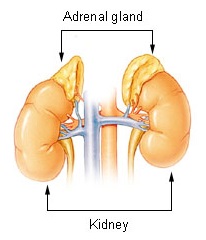First, some terminology. I've been posting about the stress response recently. What's the difference between the fight-or-flight response and the stress response? It depends on who's talking. I like to use the term “stress response” to refer only to the hypothalamic-pituitary-adrenal (HPA) axis, best known for managing the levels of cortisol in the bloodstream. I use the term “fight-or-flight response” to refer to the sympathetic-adrenomedullary (SAM) axis, best known for managing the levels of adrenaline in the bloodstream. However, some people also refer to the SAM as the “stress response,” and some subdivide the two into the “slow arm of the stress response” (the HPA) and the “fast arm of the stress response” (the SAM).
The SAM is certainly fast! This is because it sends information straight from the brain to the adrenals through the nervous system instead of having to pass the message through a couple of other hormones first.
The sympathetic nervous system
 | |
| By OpenStax College [CC BY 3.0 (http://creativecommons.org/licenses/by/3.0)] via Wikimedia Commons |
What it is: a subset of the involuntary nervous system, also known as the autonomic nervous system. The autonomic nervous system is subdivided into the sympathetic nervous system, which handles the fight-or-flight response, and the parasympathetic nervous system, which handles the rest-and-digest response.
What it does in the SAM: passes an electrical signal from the brain along the spinal cord and out to the adrenal glands.
The adrenals
 |
| By EEOC (cancer.gov) via Wikimedia Commons |
What they are: small organs next to the kidneys responsible for sending all kinds of important hormones out into the body
What they do in the SAM: in response to input from nerves of the sympathetic nervous system, they release adrenaline (also known as epinephrine) and noradrenaline (also known as norepinephrine) into the bloodstream so that they can alert different organs and tissues around the body to the need to respond to a stressor fast, fast, fast. Note that the adrenals also release a hormone in the HPA axis. The adrenals are complicated little organs with different regions involved in the production and release of different hormones. In the case of the SAM, the interior region of the adrenals, the medulla, is the responsible party. The medulla contributes the M to SAM. (The outer layer of the adrenals, the adrenal cortex, is the active region in the HPA axis.)
The minor players
The rest of the body
When adrenaline shoots into your bloodstream — well, you know what that feels like. Some people like the sensation; they are the types who seek out rollercoasters and horror movies. Some people hate it. Adrenaline tells your body to mobilize all its resources for a short term threat: your muscles get extra energy, the pupils of your eyes dilate to take in more light so you can see better, your heart beats faster and stronger, your lungs take in more air. It doesn't last long, just a minute or so.Although this response is classically associated with fight (going on the offensive) or flight (getting away from a bad situation), another common behavior associated with this response is freezing: holding very still. This is a common response in some kinds of prey animals, like mice, but any species might react this way.


So nice to see real science behind the behavior. Great blog!
ReplyDelete